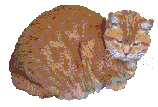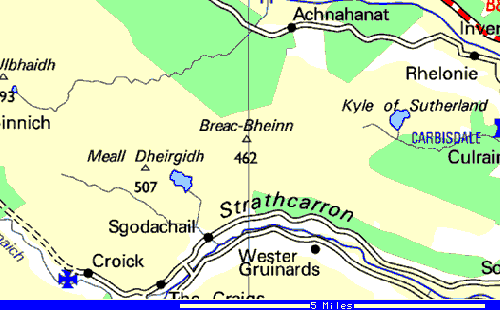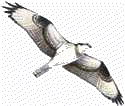
in the Scottish Highlands
A R D G A Y
AR(D)GUY, situated at the west end of the Dornoch Firth, just across the valley from Bonar Bridge and its 'bailey' style bridge over the river Carron. The "Eitag Stone", near to the village post office, marks the site of the 19th century cattle market. The cattle and sheep sales are now traded at a large purpose built market just outside Lairg., and is reputed to be the largest in Europe.
The village war memorial for world war I is inscribed as the 1914-1919 war, which I have not come across elsewhere! (No longer true, the war memorial at Cawdor has the same inscription) A 'rare animal' croft is situated about 4 miles west of Ardgay along the Strathcarron Valley. A further 8 miles will bring you to the little church at Croick. Small in size but steeped in history.
Instead of following Strathcarron, you can turn to the right when you cross the river, signposted Inveroykel and Culrain, and in 4 miles arrive at Carbisdale Castle gifted to the Scottish Youth Hostels Association together with the contents of the castle and the estate in 1945.
The castle was built by the Sutherland family (of Dunrobin Castle) to house Mary Caroline Mitchell who married the 3rd Duke and 18th Earl of Sutherland, making her a Duchess. She became known as the "Duchess Blair" after her first husband Captain Arthur Kindersley Blair of the 71st Highland Light Infantry, who was shot and died from his wounds in a hunting accident near Pitlochry in 1883.

The marriage was very unpopular with the Sutherland family and when the 3rd Duke died in 1892, leaving "all his worldly goods" to the Duchess, the family contested the will, and during the contesting of the will, the Duchess was imprisoned for six weeks in Holloway Prison, London. She had apparently destroyed some documents and was found guilty of contempt of court
Agreement was finally reached giving her a substantial financial settlement and the Sutherland family agreed to build a residence befitting her station, at their expense and to her specifications, provided that it was situated outside Sutherland lands. A firm of Ayrshire builders started building the castle in a prominent position on Carbisdale Heights just north of the village of Culrain in 1906. The castle was completed in 1917.
The widowed Duchess Blair remarried and in 1933, the castle was bought by Colonel Theodore Salvesen, the head of the Christian Salvesen shipping and whaling company of Leith. During world war II, refuge was given to King Haakon VII of Norway and the Crown Prince during the Nazi occupation of Norway during world war II. Today, I have learned something new. Following the attack by Germany on Russia on 22nd June, 1941, an agreement was made at Carbisdale Castle which ensured that Russian forces, should they enter Norwegian territory, would not remain there after the war. The Red Army entered Norway on 25th October, 1944 in pursuit of the German 28th Army. The Red Army captured thirty towns in Norway including Kirkenes, but later withdrew in the terms of an agreement made at Carbisdale Castle with the Norwegians and the representatives of Britain.
Carbisdale Castle has housed wealthy and influential people, has been a convalescent home for British military officers and has served as a royal refuge. It is now a centre of goodwill and friendship shared by youth hostellers of many nations, with a large conference centre

Croick Church
In May, June, July, August and September, on the second Sunday of those months at 3 p.m. The Sacrament of Holy Communion is celebrated at 3 p.m. on the second Sunday in July
During the other months, the monthly services are held in the Mission Hall, 1/2 mile down the road at the turning off to Amat.
The Church is open at all times and all are welcome to its services. If you wish, leave a message on the "Prayer Tree"
Following the Napoleonic Wars, Parliament voted funds for the building of 43 churches and manses in the remoter parts of the Highlands where the local landlords were prepared to provide sites. Such a site was offered by the Rosses of Balnagowan. The designs chosen were those of the famous engineer Thomas Telford, the builder of the Caledonian Canal, amongst other things. The building of the church was completed in 1827 and its first minister, Robert Williamson, was inducted in September 1828. He remained there until 1840 when he emigrated to Nova Scotia taking some of his congregation with him.
Not wishing to provide a long history lesson, let me just say that the area around Croick was destined to be commercial sheep farming and the small tenant farmers were driven from the land in 1845, not necessarily by the landlord Sir John Lockhart Ross of Balnagowan., but certainly he was responsible for introducing sheep into the Highlands in general. Known as the Clearances, 18 families were cleared from Glencalvie, and later (1854) from Greenyards in Strathcarron, where they had lived for generations. The families comprising about 90 people took shelter in Croick churchyard and their wretched plight in recorded in messages scratched on the outside of the east window of the church. The scratched windows are protected from within and without and the writings can be seen clearly.

I suppose that it ironic to say that now, 1998, sheep farming has almost died out and the land is being replaced by forestry.
Last Update: 31st, May, 2000